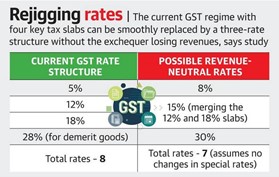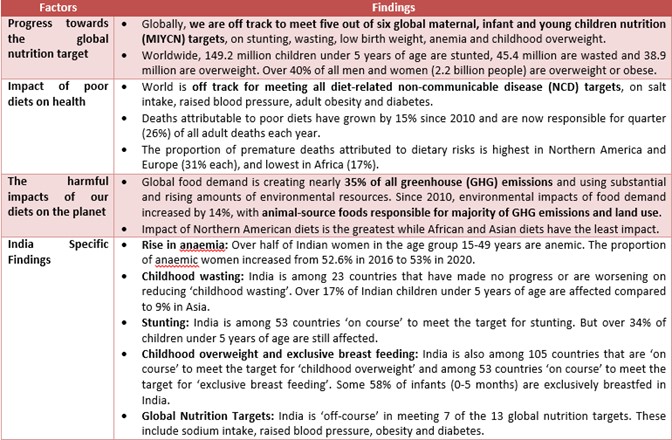Tuesday, 30th November 2021
3D-printed cryogenic engine
In News
Hyderabad-based start-up Skyroot Aerospace has successfully demonstrated the India’s first privately developed cryogenic rocket engine named Dhawan-1.
About the News
- The cryogenic rocket engine named Dhawan-1 after the eminent rocket scientist Satish Dhawan, will be used as the upper stage of company’s Vikram-2 launch vehicle.
- Vikram-2 is one of three launch vehicles Skyroot has designed specifically for launching small satellites.
- The other two launch vehicles being Vikram-1 and the largest rocket, Vikram-3.
- The complex engine’s start and shut-off transients were found to be perfectly smooth with combustion very stable, and pressure that was rock steady.
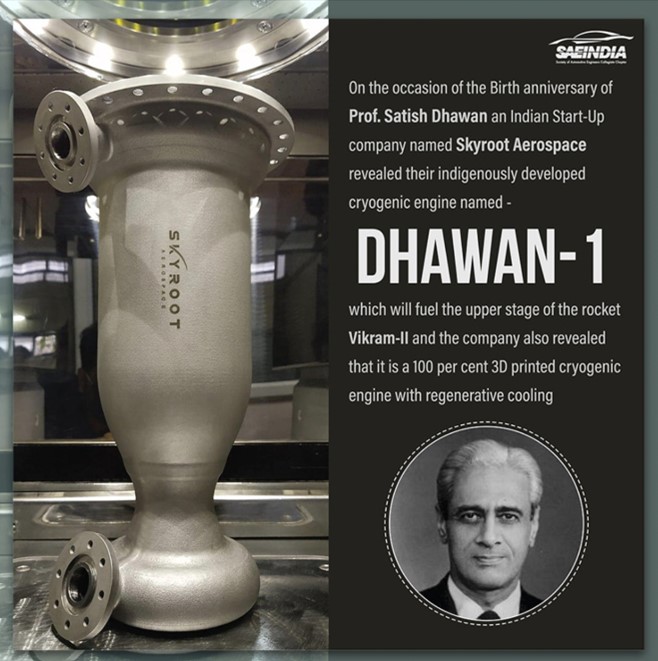
Features of the Dhawan-1 Engine
- 3D Printed: The engine has been completely 3D printed and made in India. A superalloy for 3D printing the engine was used which reduced the manufacturing time by 95%.
- Cryogenic in Nature: Dhawan 1 is a cryogenic engine.
- Cryogenic engines use liquefied gasses at temperatures as low as -150 0 C as propellants. They are highly efficient and can aid rockets in carrying heavier payloads.
- India’s heaviest launch vehicles – GSLV and GSLV Mk III – use cryogenic fuel in the upper stage of the launch vehicle.
- Cryogenic engines are one of the hardest to develop and so far only six countries have these launch vehicles including the US, China, Russia, France, Japan, and India. India used its first GSLV in 2001.
- Complex system: A cryogenic engine/ cryogenic stage is the last stage of space launch vehicles which makes use of Cryogenics. Cryogenic stage is technically a much more complexed system with respect to solid or liquid propellant (stored on earth) stages due to the usage of propellants at extremely low temperatures..
- Green Fuel used: While all cryogenic engines in use today use a combination of liquid oxygen and hydrogen as fuel, the Skyroot cryogenic engine will use Liquid Natural gas (LNG) and Liquid Oxygen (LoX) as propellants. LNG, which is more than 90% methane, is considered the rocket fuel of the future.
- High in Efficiency: The propellants to be used in Dhawan-1 are high performance, low-cost, and green that increases the performance and in turn the efficiency of the engine. The other advantages of the LNG propulsion system include:
- lower risk of explosion
- less costly propellants and
- the fuel is less evaporable in space, that makes it suitable for a vehicle that travels to space for a prolonged period.
Where it can be used?: Cryogenic engine, 3D printing, Space,
Source:
- Start-up displays India’s first privately developed, 3D-printed cryogenic engine
- Desi space start-up test fires India’s first privately built 3D printed cryo engine
- Skyroot successfully test fires India's first privately developed cryogenic rocket engine
Image Source:
Cross-border insolvency cases
In News
Ministry of Corporate Affairs has published for consultation the draft legal framework for cross-border insolvency cases based on the UNCITRAL model law.
About the News
The government has published a draft insolvency resolution framework based on the UNCITRAL model law and it is proposed to be made applicable for both corporate debtors as well as personal guarantors to such debtors.
- Cross border insolvency proceedings: These proceedings apply to those debtors who have assets and creditors overseas across multiple jurisdictions. A framework for cross border insolvency proceedings allows for the
- Location of such a company’s foreign assets
- The identification of creditors and their claims and establishing payment towards claims
- Process for coordination between courts in different countries.
- Need for the framework: While foreign creditors can make claims against a domestic company, the IBC currently does not allow for automatic recognition of any insolvency proceedings in other countries.
- Hence, a need for having robust institutional arrangements to deal with cross-border insolvency issues has gained momentum during the last few decades. E.g., In Jet Airways case, there was lack of clarity regarding Dutch proceedings against the company.
- Based on the feedback, a Bill to amend the Insolvency and Bankruptcy Code (IBC) will be moved.

Features of the draft framework
- The framework aims to empower insolvency professionals (IPs) and creditors to access assets outside India of corporate debtors, maximising the value for all stakeholders.
- Foreign creditors to an Indian entity to become party to bankruptcy proceedings if the borrower goes bankrupt.
- The framework for cross border insolvency adopted in India would require reciprocity from any country which seeks to have its insolvency proceedings recognised by Indian courts.
Exemption under the draft framework
- According to recommendations by MCA, companies undergoing the Pre-packaged Insolvency Resolution Process (PIRP) will be exempted from cross border insolvency proceedings as the provisions for PIRP have been introduced recently.
- It has also been recommended that the Indian cross border insolvency framework exclude financial service providers such as banks and insurance companies, from being subjected to cross border insolvency proceedings.
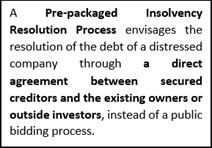
Where it can be used?: IBC, Cross-border insolvency
Source:
- Cross border insolvency: UN model allows automatic recognition of foreign rulings
- Govt. proposes framework for cross-border insolvency; seeks comments till December 15
- Cross-border insolvency cases: Government will soon put out for consultation the draft legal framework
Suspension of MPs from Parliament
In News
Recently, 12 MPs have been suspended for disruptions in Rajya Sabha during the Monsoon Session.
About the News
The recent suspension of 12 MPs from Rajya Sabha for the entire Winter Session of Parliament for their "unruly" conduct in the previous session is the biggest such action in the history of the Upper House.
Reasons behind frequent disruption of Parliament
- Dissatisfaction in MPs (particularly from Opposition parties) because of inadequate time for airing their grievances: There is need for a system, like that of the British Parliament, where certain days in a week in each Parliamentary session where the opposition parties are allowed to determine the agenda for the days discussion.
- An unresponsive attitude of the government: Government should be opened to discuss ideas and be responsive to suggestions.
- Disruptions May Help Ruling Party Evade Responsibility: Every political party in power has been accused of evading parliamentary scrutiny of the executive in the garb of disruption.
- Opposition members are accused of disrupting house to stall passes of the bill to which they are opposed to.
- Live debates: While telecasting parliamentary sessions live increases transparency and accountability of the Parliament, it also creates incentive for the MPs to grab public attention by disrupting the house.
Impact of disruption
- Reduced productivity of Parliament: Monsoon Session in 2021 had one of the poorest productivities in recent years. Lok Sabha percentage productivity was 21%.
- This leads to delayed passage of bills and reduced parliamentary scrutiny of executives.
- Erodes images of the Parliament among the Public: If disruptions in Parliament continue then slowly but surely it would lead to people slowly disengaging with the institution of Parliament.
- Opportunity cost of delayed legislation: Like GST was first introduced in 2011 but one of the factors responsible for its roll out in 2017 was Parliamentary disruptions which means it was not being debated enough in the house.
- Direct financial cost: There have been several estimates on the cost to the exchequer due to the disruptions. These vary from a few crore rupees to a few hundred crore rupees.
Powers with presiding officers to deal with MPs disrupting proceedings
- Direction to MPs to remain absent of remainder of the day: The presiding officer of each House can direct an MP to withdraw from the legislative chamber for grossly disorderly conduct. The MP then has to remain absent from the proceedings of the House for the remainder of the day.
- Suspension: The presiding officers can also “name” an MP for “persistently and wilfully obstructing the business” of the House. In such a case, usually, the Parliamentary Affairs Minister moves a motion for suspending the offending MP from the service of the House. The suspension can last until the end of the session.
- Power of automatic suspension: Lok Sabha rule, 374A, empowers the Speaker to automatically suspend an MP for a maximum of five days for disrupting the business of the House.
Where it can be used?: Parliament, Parliamentary oversight
Source:
R.C. Dutt
On November 30, 1909 Romesh Chunder Dutt died. Better known as RC Dutt, he was born on 13 August 1848 in the well-known Dutt family of Ramnagar, Calcutta. Barely 20 years old, Romesh Chunder Dutt set out, without informing his family, on a slow boat from Calcutta to Diamond Harbour and thence to catch a steamer to London, to study and compete for the ICS. The first publication of Romesh Dutt was his 'Three Years in Europe', which appeared in 1872. His next work was Bengal Peasantry (1875). In this work he championed the cause of the raiyats and urged that their rent rate should be fixed. Three publications by Dutt dealt with the economic effects of British colonial rule in India. These were England and India (1897), Famines in India (1900) and the two volumes of the Economic History of India. In 1899 Dutt joined active politics. In December of that year he presided over the annual conference of the indian national congress held in Lucknow. Like other 'Moderates' (Dadabhai Naoroji, Suredranath Banerjee, WC Bonerjee, Justice Ranade) Dutt believed that British rule was essentially for the good of the country.

Source:
Reconceptualization of MSP
In News
Farmers’ organisations continue to demand guaranteed minimum support prices (MSPs) before they withdraw their agitation, even after the government has repealed the three farm laws.
What is Minimum Support Price (MSP)?
- Minimum Support Price (MSP) is the assured price at which foodgrains are procured from farmers by the central and state governments and their agencies, for the central pool of foodgrains.
- The central pool is used for providing foodgrains under the Public Distribution System (PDS) and other welfare schemes, and also kept as reserve in the form of buffer stock.
- Government notifies MSPs annually for 23 commodities inclusive of 14 kharif, 7 rabi and 2 calendar year season crops. In addition to these 23 crops, Government also notifies Fair and Remunerative Prices (FRP) for sugarcane and jute.
- The Government notifies MSPs based on the recommendations of an independent body, called Commission for Agricultural Costs and Prices (CACP).
- The CACP considers all paid out costs in respect of the above variables, called A2 and the imputed value of family labour. Thus, CACP recommendation is a function of:
- A2 = Actual expenses in cash and kind, including rent paid for leased-in land.
FL = Imputed value of family labour
Further, CACP adds a certain percentage of the A2 cost as a profit margin and this together is recommended as MSP to the Government.

What are the major issues with the MSP & Procurement Mechanism?
- Impact on Cropping Pattern: The Economic Survey 2019-20 observed that the regular increase in MSP is seen by farmers as a signal to opt for crops which have an assured procurement system (for example, rice and wheat).
- This skews the production of crops in favour of wheat and paddy (particularly in states where procurement levels are high), and does not offer an incentive for farmers to produce other items such as pulses. Further, this puts pressure on the water table as these crops are water-intensive crops.
- Lack of Awareness: A few selected States in Eastern India (for instance, Assam and West Bengal), the poor impact of the scheme may be judged by the fact that none of the selected farmers were even aware of the existence of such a Scheme.
- Payment delays: Delays in MSP payments have negative effects on the farmers and needs to be corrected to ensure timely payments.
- Also, MSP should be announced well in advance of the sowing season so as to enable the farmers to plan their cropping.
- Logistics and Storage issues: The procurement of MSP notified commodities, other than wheat and Paddy, has not been very encouraging. The experience so far exhibits that procurement has largely benefited wheat and paddy growers where almost 33 per cent of the marketed surplus crop is procured.
- Non-Secular growth: It is well established, that the status of procurement linked to MSP has not been secular either in terms of crops covered or geographic spread. Taking for example, in case of wheat, of the average of 33 per cent of marketed surplus procured, 90 per cent is accounted for in Punjab, Haryana and Madhya Pradesh.
What can be solution/s to these problems?
- Infrastructure Development: Improved facilities at procurement centres, such as drying yards, weighing bridges, toilets, etc. should be provided to the farmers. More warehouses/silos should be set up and maintained properly for better storage and reduction of wastage.
- Consultative determination of MSP: There should be meaningful consultations with the State Government, both on the methodology of computation of MSP as well as on the implementation mechanism. The principles for fixing MSP should be current year’s data and based on more meaningful criteria rather than on historical costs.
- Aid to Small farmers: The small and marginal farmers can be provided with some exemption in Fair Average Quality (FAQ) norms to provide them with a source of income. The Procurement Centres should be in the village itself, to avoid transportation costs to farmers.
- Increasing Reach: The MSP scheme requires a complete overhaul in those States where the impact of the scheme ranges from ‘nil’ to ‘at-best marginal’ to ensure that MSP as an important instrument of the Government’s agricultural price policy is not undermined.
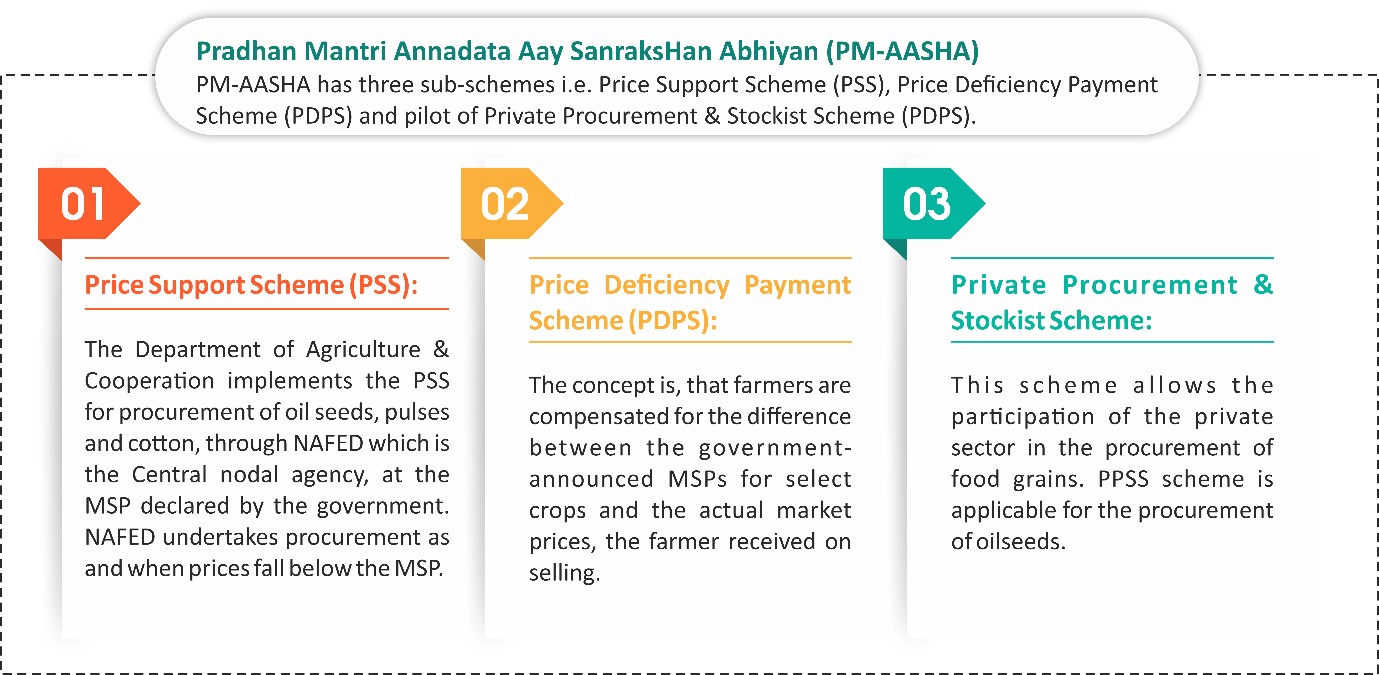
Way Forward
- MSP as Fall-back system: MSP is clearly intended as a safety net and not be seen as the desired economic outcome for farmers. Agricultural sector requires interventions beyond MSP so that it is optimised as a market led activity and is driven by value that is demand led.
- Robust Procurement Mechanism: In addition to strengthening the existing procurement schemes, more such tools be developed and deployed to enhance the support and its reach across the country & across crops, besides improving speed of response and effectiveness of procurement, in cases where prices may drop below MSP.
- Efficient Market System: Though marketing in general and agriculture marketing in particular cannot be perfect or even near perfect in the classical sense, efficient market system has an important role in transferring remunerative prices (that are more than the MSP) to the farmers.
- Thus, market architecture and marketing system must be improved, to enable farmers to capture the more optimal share of the market value of their produce. Over time, MSP should be the second choice for any farmer, with markets being the preferred method of monetising their produce.
Question: Despite noble intentions behind MSP mechanism, it has not been successful in its reach or efficiency. Elaborate.
Where it can be used?: MSP, Public Procurement, agriculture
Sources:
Atacama desert as dumping ground
This is image of Chile's Atacama desert, which has become a dumping ground for fast fashion leftovers. Chile's Atacama desert is the driest desert in the world. It receives almost no rainfall and supports no animal or plant life. But it is one of the best places in the world to conduct astronomical observations. The soil in this region is remarkably similar to that of Mars, making it a perfect spot for experiments. But now, this desert is suffering from pollution created by fast fashion. Huge heaps of discarded clothes ranging from sweaters to ski boots are dumped here Chile has been a centre of used and unsold clothes made in China or Bangladesh and passing through Europe, Asia or the United States. Around 59,000 tonnes of clothes arrive each year at the Iquique port in the Alto Hospicio free zone in northern Chile. Only a part of this is sold. Around 39,000 tonnes of clothing that cannot be sold are been dumped at the desert.

Source:
Zero Defect Zero Effect Scheme
- Context: A number of MSMEs have registered with intent to adopt the principle of the Zero Defect Zero Effect Scheme (ZED).
- The ZED certification scheme aims to enhance the productivity and competitiveness of mico, small and medium enterprises (MSMEs) through the adoption of zero defect production processes that have a low/no impact on the environment.
- The scheme supports the 'Make in India' campaign and encompasses elements to:
- Develop an Ecosystem for Zero Defect Manufacturing in MSMEs
- Promote adaptation of quality tools/systems and energy efficient manufacturing
- Enable MSMEs for manufacturing of quality products
- Encourage MSMEs to constantly upgrade their quality standards in products and processes and
- Develop professionals in the area of ZED manufacturing and certification.
- Quality Council of India (QCI) has been appointed as the National Monitoring & Implementing Unit (NMIU) for implementation of ZED.

Source:
- Zero Defect Zero Effect Scheme
- Zero Defect Zero Effect (ZED) Certification Scheme
- ZED Scheme for MSMEs
Image Source:
Increasing C Section: NFHS
- Context: The recent NFHS data has found an increase in the number of C sections.
- One in two women who go to a private hospital undergoes a Caesarean section (C-section.
- There is an increasing trend in private medical facilities where C sections have gone up from 40.9% to 47.4% that has led to a jump in pan-India numbers. This means that one in five women who go to any medical facility, private or public, undergoes a C-section.
- Bihar has only 3.5% C-sections in public health facilities, indicating inability to provide critical care to prevent maternal and infant deaths.
- When medically justified, a C-section can effectively prevent maternal and perinatal mortality and morbidity. According to WHO, the ideal rate is between 5% and 15%.
- Women having babies at a later age, increase in in-vitro fertility and sedentary lifestyle of mothers are some of the reasons are the various reasons for this increase.
- Public hospitals see a rise in C-sections because of poor doctor-patient ratio and concentration of high-risk pregnancies at one place with less doctors and less caregivers.
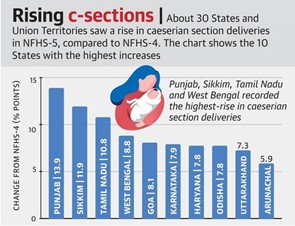
Source:
- One in two women in private hospitals undergo C-section, shows NFHS data
- One in two women in private hospitals undergo C-section, shows NFHS data
Image Source:
Multisystem Inflammatory Syndrome
- Context:WHO has recently issued updated guidelines on the management of multisystem inflammatory syndrome in children associated with COVID-19 (MIS-C).
- MIS-C is a rare but serious condition where children with COVID-19 develop inflammation affecting different organs of the body.
- The infection may show up in the form of either symptoms or other problems among adults in the first phase. In the second phase it leads to a dip in oxygen levels in blood , hypoxia
- Among children, there may not be a first phase of infection as most of them are asymptomatic and they may directly enter the second phase.
- Children with this condition need specialized care, and may need to be admitted to intensive care.
- Although MIS-C is a serious condition, children recover with the right medical care.

Source:
- WHO issues guidelines on the treatment of children with multisystem inflammatory syndrome associated with COVID-19
- Coronavirus | Children could be prone to multisystem inflammatory syndrome
Image Source:
River Cities Alliance
- Context: National Mission for Clean Ganga & National Institute of Urban Affairs have jointly organised River Cities Alliance (RCA).
- It is a dedicated platform for river cities in India to ideate, discuss and exchange information for sustainable management of urban rivers.
- It is the first of its kind Alliance that will focus on three broad themes: (a) Networking (b) Capacity Building and (c) Technical Support.
- Sustainable management of urban rivers includes:
- minimizing their water footprint,
- reducing impacts on river and water bodies,
- capitalizing on natural, intangible, architectural heritage etc and develop self-sufficient, self-sustainable water resources through recycle, reuse strategy.
- The Alliance cities will work towards adopting and localizing national policies and instruments with key river-related directions, prepare their Urban River Management Plans and develop city-specific sectoral strategies for sustainable urban river management.
- This will strengthen their governance aspects and attracts external economic investments, access state of the art knowledge and frameworks etc.
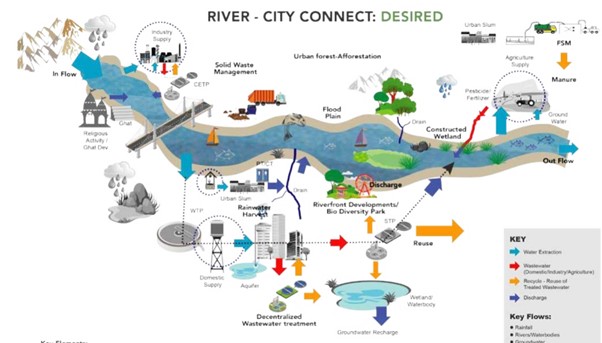
Source:
- Union Minister for Jal ShaktiShri Gajendra Singh Shekhawat Launches River Cities Alliance -A Dedicated Platform For River Cities In India To Ideate, Discuss And Exchange Information For Sustainable Management of Urban Rivers
- NMCG-NIUA launches River Cities Alliance for river enhancement
Image Source:
Implications of using bankruptcy code against discoms: IE
Essence: The article highlights the need to bring state government-owned electricity distribution companies (discoms) under IBC. Many efforts have been made to revive the discoms like bail out, proposal to privatise and delicensing electricity distribution itself but all of it was met with opposition. The last resort left to revive them is enabling creditors to trigger IBC proceedings against discoms. This could pose some challenges too like due to factors like consumer mix and geography being important determinants of a discom’s commercial viability.
Successful privatisation through IBC would depend on multiple factors like the consumer mix and geography are important determinants of a discom’s commercial viability. Along with that there are major challenges associated like issue of distribution licenses and set tariifs are still under government control. Policymakers need to think that insolvency of such utility services would require special treatment to ensure continuity of supply.
Why you should read this article?
- To understand different steps that could be taken to revive discoms.
- To understand issues associated with bring discoms under IBC.
- To understand the things that the policymakers need to keep in mind while drafting a policy for successful implementation of bringing discoms under IBC.
Source:
The many challenges before Trade Unions: TH
Essence: With the repeal of three farm laws, Trade unions have intensified their agitation against the Labour Codes. There is a need for assessment of the revival of protests of Industrial Workers. The problems with the code as highlighted by Central Trade Union (CTUs) are many. There was absence dialogue/discussion/debate in Lok Sabha. Also, the drafting of code is incomplete. The government has left many substantial procedural clauses to the rule making processes which will create a clash with states making rule on the same subject. The codes do not reflect several recommendations made by the Parliamentary Standing Committee. But also important is to highlight the failure of trade unions in achieving their aim.
The article has also discussed why strikes by trade unions have been unsuccessful in India. There is no unity among trade unions due to their different political affiliation. Some of them even lack political consciousness. The unorganised workers are not organised in a consolidated manner which effects their demands and opposition. Due to their state of underemployment or unemployment, they have weak bargaining powers and cannot organize long strikes. Labour reforms agenda of privatization are supported by many global financial institutions which is a challenging for unions to oppose. The unions are required to come with agitation strategies or take the legal path to challenge these codes.
Why to read this article?
- To understand the problems with the Labour Code and why strikes of the Trade unions have been unsuccessful in India.
- After the repeal of farm laws, the issue of Labour Codes becomes relevant for GS paper III in understanding pros and cons of the Labour code and the role of Trade Unions.
Source:
China has shown how not to conduct business with other states: IE
Essence: The editorial highlights the geo-political tussle between USA and China in Asia-Pacific region and how both these nations are trying to balance supremacy in the region. New groupings like QUAD and AUKUS and re-invigorated ties with Japan and South Korea highlight how USA is engaging its allies in Asia. On the other hand, though China has a global economic outreach, its political and military ties are limited. It has alliances with Russia, North Korea and Pakistan in various domains of strategic interests.
There are reasons to suggest why China would dominate the landscape in Asia- geographical distance between USA and Asia, China’s hard power and economic might influencing the Asian economy. But these “wolf warrior” policies are only driving the nations away from Chinese to USA’s camp. Even though Chinese hegemony could be inevitable, the present situation shows how not to conduct business with other states
Why you should read this article?
- To understand the impact of Chinese economy and military in Asia.
- To understand the various ways the Presidents in USA have tried to balance their presence in Asia.
- To gain an insight into Asian geopolitics.
Source:
Reviving of Natural Lake by Localities
Background
- Chennai in 2019 had made national headlines as its water crisispeaked to an alarming level.
- Anthropogenic activities have led to the drying up of lakes and rivers leading to acute water and environmental issues.
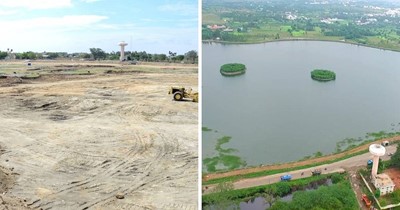
Efforts of localities in reviving a natural lake
- Efforts of Kumar Duraisamy, a local from Tiruppur, Chennai led to the revival of Lake Andipalyam.
- He inspected the lake to better understand the issue and aim for rejuvenation accordingly.
- Excessive extraction of water was one of the major causes of the depletion of the lake.
- Local people from the area were asked to pitch in for removing the accumulated silt. This generated a sense of belongingness towards the lake among the locals.
- Later, the localities pooled in resources for the sustenance of the lake bring new life to the area.
Quote: We need agricultural land and infrastructure on land that was once forest, for example, and ecosystems, like societies, must adapt to a changing climate.
Source:
Share the article
Get Latest Updates on Offers, Event dates, and free Mentorship sessions.

Get in touch with our Expert Academic Counsellors 👋
FAQs
UPSC Daily Current Affairs focuses on learning current events on a daily basis. An aspirant needs to study regular and updated information about current events, news, and relevant topics that are important for UPSC aspirants. It covers national and international affairs, government policies, socio-economic issues, science and technology advancements, and more.
UPSC Daily Current Affairs provides aspirants with a concise and comprehensive overview of the latest happenings and developments across various fields. It helps aspirants stay updated with current affairs and provides them with valuable insights and analysis, which are essential for answering questions in the UPSC examinations. It enhances their knowledge, analytical skills, and ability to connect current affairs with the UPSC syllabus.
UPSC Daily Current Affairs covers a wide range of topics, including politics, economics, science and technology, environment, social issues, governance, international relations, and more. It offers news summaries, in-depth analyses, editorials, opinion pieces, and relevant study materials. It also provides practice questions and quizzes to help aspirants test their understanding of current affairs.
Edukemy's UPSC Daily Current Affairs can be accessed through:
- UPSC Daily Current Affairs can be accessed through Current Affairs tab at the top of the Main Page of Edukemy.
- Edukemy Mobile app: The Daily Current Affairs can also be access through Edukemy Mobile App.
- Social media: Follow Edukemy’s official social media accounts or pages that provide UPSC Daily Current Affairs updates, including Facebook, Twitter, or Telegram channels.


